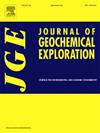俄罗斯堪察加AuAg浅成热液矿床中黄铁矿微量元素:与矿物系统地球化学特征比较
IF 3.3
2区 地球科学
Q1 GEOCHEMISTRY & GEOPHYSICS
引用次数: 0
摘要
采用激光烧蚀电感耦合等离子体质谱法(LA-ICP-MS)分析了俄罗斯勘察加半岛AuAg浅热液系统中紫砂绢云母(LS型)矿床(Aginskoe、Baranyevskoe、Rodnikovoe和Kumroch)和硫酸酸(HS型)矿床(Maletoyvayam)中黄铁矿中的微量元素。在大多数研究的矿床中,黄铁矿中金的浓度不超过10ppm。大多数矿床黄铁矿的Au/Ag比小于1,但Aginskoe矿床黄铁矿的Au/Ag比为120 ppm,与该矿床的富金矿相似,Au/Ag比为>;1。两种矿床类型的黄铁矿中铜(Cu)的浓度均达到10,000 ppm。然而,铜与银的正相关关系仅在铜绢云母型矿床(Kumroch、Rodnikovoe和Aginskoe)中存在,这与这些矿床中含银的磺胺盐的存在一致。软绢云母矿床的中性和碱性条件有利于成矿系统的富集,其中黄铁矿的富集程度最高可达10,000 ppm。在碲化物通常存在的矿床的黄铁矿中发现了中等浓度的Te(高达100 ppm),除了来自ronikovoe矿床的贫Te黄铁矿(<10 ppm),其中没有碲化物矿物。相比之下,Maletoyvayam矿床的酸性条件导致了矿石系统中Se、Te和Sb的富集,促进了这些元素进入黄铁矿(Se高达10,000 ppm, Te和Sb各为1,000 ppm),以及含有这些元素的矿物的形成。所有矿床的黄铁矿中均含有适量的铅和锌,而方铅矿和闪锌矿仅在Kumroch矿床中常见;它们的存在可能受到结构性因素的限制。硫铁矿中微量元素以固溶体或纳米团簇形式存在,对堪察加浅成热液型金银矿床的矿石组合形成起着重要作用。成矿系统的地球化学专一化是控制这些过程的主要因素,而矿床的物理化学条件也显著影响这些微量元素在黄铁矿中的富集。本文章由计算机程序翻译,如有差异,请以英文原文为准。

Trace elements in pyrite from AuAg epithermal deposits of Kamchatka, Russia: Comparison with geochemical features of mineral systems
Trace elements in pyrite from adularia-sericite (LS type) deposits (Aginskoe, Baranyevskoe, Rodnikovoe, and Kumroch) and acid-sulfate (HS type) deposits (Maletoyvayam) of Au![]() Ag epithermal systems in Kamchatka, Russia, were analyzed using laser ablation inductively coupled plasma mass spectrometry (LA-ICP-MS). In most of the studied deposits, the concentration of Au in pyrite did not exceed 10 ppm. The Au/Ag ratio in pyrites from most deposits is less than 1, except for the Aginskoe deposit, in which pyrite is notably enriched in Au (up to 120 ppm), similar to the Au-rich ores of this deposit with an Au/Ag ratio >1. The concentration of copper (Cu) in pyrite reaches 10,000 ppm in both deposit types. However, Cu is positively correlated with Ag only in the adularia-sericite type deposits (Kumroch, Rodnikovoe, and Aginskoe), aligning with the presence of Ag-containing sulfosalts in these deposits. The neutral and alkaline conditions in the adularia-sericite deposits contribute to an enrichment of the ore-forming system in As, which is significantly concentrated in pyrite (up to 10,000 ppm). Moderate concentrations of Te (up to 100 ppm) were found in pyrite from deposits where tellurides are typically present, with the exception of the Te-depleted pyrite (<10 ppm) from the Rodnikovoe deposit, where telluride minerals were absent. In contrast, the acidic conditions at the Maletoyvayam deposit led to the enrichment of the ore system in Se, Te, and Sb, facilitating the incorporation of these elements into pyrite (up to 10,000 ppm Se, and 1000 ppm each for Te and Sb), as well as the formation of minerals containing these elements. Lead and zinc are moderately present in the pyrite from all deposits, while galena and sphalerite are commonly found only in the Kumroch deposit; their presence may be limited by structural factors. The trace elements found in pyrite, either as solid solutions or nanoclusters, play an important role in the formation of ore assemblages in all studied epithermal Au
Ag epithermal systems in Kamchatka, Russia, were analyzed using laser ablation inductively coupled plasma mass spectrometry (LA-ICP-MS). In most of the studied deposits, the concentration of Au in pyrite did not exceed 10 ppm. The Au/Ag ratio in pyrites from most deposits is less than 1, except for the Aginskoe deposit, in which pyrite is notably enriched in Au (up to 120 ppm), similar to the Au-rich ores of this deposit with an Au/Ag ratio >1. The concentration of copper (Cu) in pyrite reaches 10,000 ppm in both deposit types. However, Cu is positively correlated with Ag only in the adularia-sericite type deposits (Kumroch, Rodnikovoe, and Aginskoe), aligning with the presence of Ag-containing sulfosalts in these deposits. The neutral and alkaline conditions in the adularia-sericite deposits contribute to an enrichment of the ore-forming system in As, which is significantly concentrated in pyrite (up to 10,000 ppm). Moderate concentrations of Te (up to 100 ppm) were found in pyrite from deposits where tellurides are typically present, with the exception of the Te-depleted pyrite (<10 ppm) from the Rodnikovoe deposit, where telluride minerals were absent. In contrast, the acidic conditions at the Maletoyvayam deposit led to the enrichment of the ore system in Se, Te, and Sb, facilitating the incorporation of these elements into pyrite (up to 10,000 ppm Se, and 1000 ppm each for Te and Sb), as well as the formation of minerals containing these elements. Lead and zinc are moderately present in the pyrite from all deposits, while galena and sphalerite are commonly found only in the Kumroch deposit; their presence may be limited by structural factors. The trace elements found in pyrite, either as solid solutions or nanoclusters, play an important role in the formation of ore assemblages in all studied epithermal Au![]() Ag deposits in Kamchatka. The geochemical specialization of ore-forming systems is the main factor controlling these processes, while physical and chemical conditions of ore deposition also significantly influence the enrichment of these trace elements in pyrite.
Ag deposits in Kamchatka. The geochemical specialization of ore-forming systems is the main factor controlling these processes, while physical and chemical conditions of ore deposition also significantly influence the enrichment of these trace elements in pyrite.
求助全文
通过发布文献求助,成功后即可免费获取论文全文。
去求助
来源期刊

Journal of Geochemical Exploration
地学-地球化学与地球物理
CiteScore
7.40
自引率
7.70%
发文量
148
审稿时长
8.1 months
期刊介绍:
Journal of Geochemical Exploration is mostly dedicated to publication of original studies in exploration and environmental geochemistry and related topics.
Contributions considered of prevalent interest for the journal include researches based on the application of innovative methods to:
define the genesis and the evolution of mineral deposits including transfer of elements in large-scale mineralized areas.
analyze complex systems at the boundaries between bio-geochemistry, metal transport and mineral accumulation.
evaluate effects of historical mining activities on the surface environment.
trace pollutant sources and define their fate and transport models in the near-surface and surface environments involving solid, fluid and aerial matrices.
assess and quantify natural and technogenic radioactivity in the environment.
determine geochemical anomalies and set baseline reference values using compositional data analysis, multivariate statistics and geo-spatial analysis.
assess the impacts of anthropogenic contamination on ecosystems and human health at local and regional scale to prioritize and classify risks through deterministic and stochastic approaches.
Papers dedicated to the presentation of newly developed methods in analytical geochemistry to be applied in the field or in laboratory are also within the topics of interest for the journal.
 求助内容:
求助内容: 应助结果提醒方式:
应助结果提醒方式:


